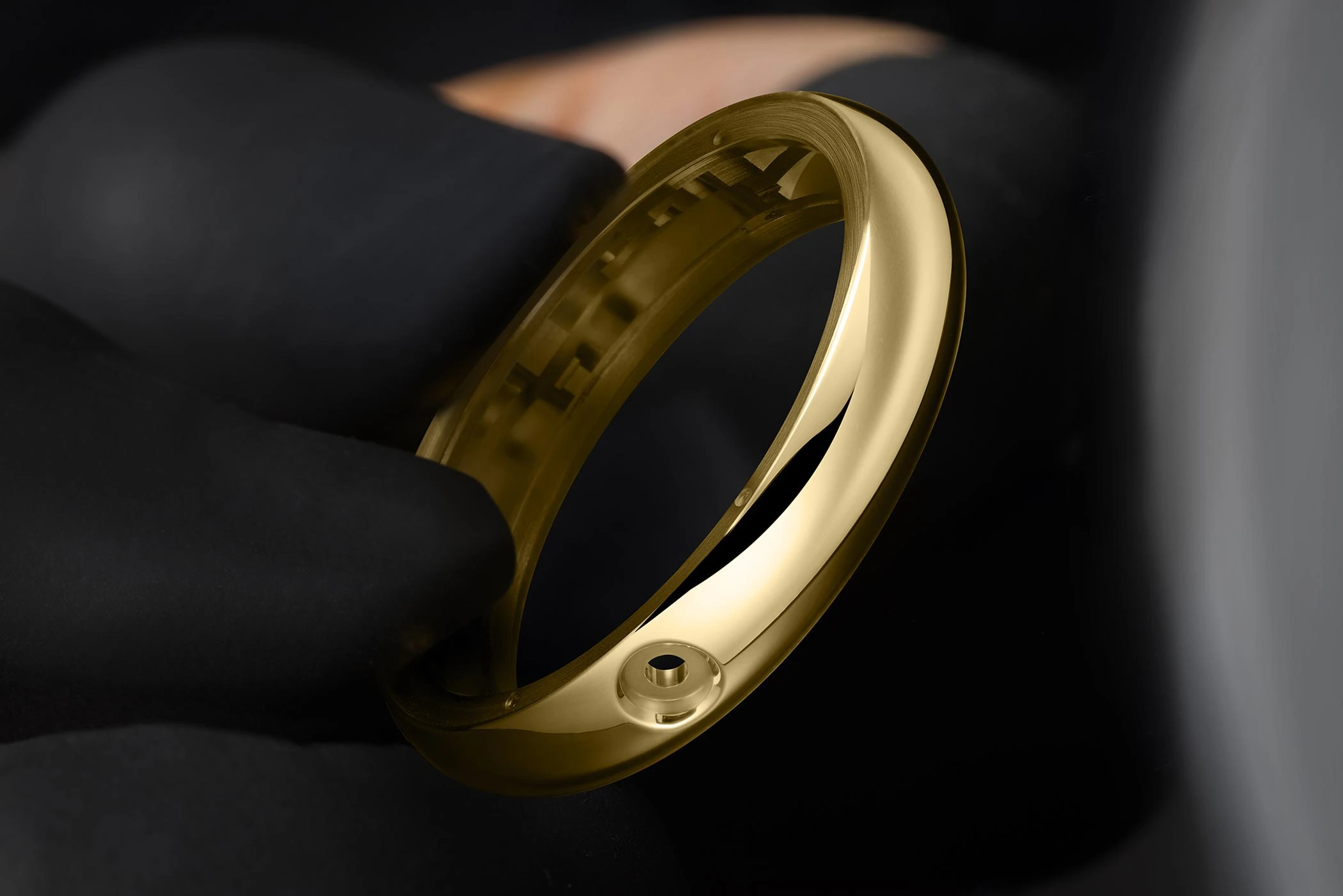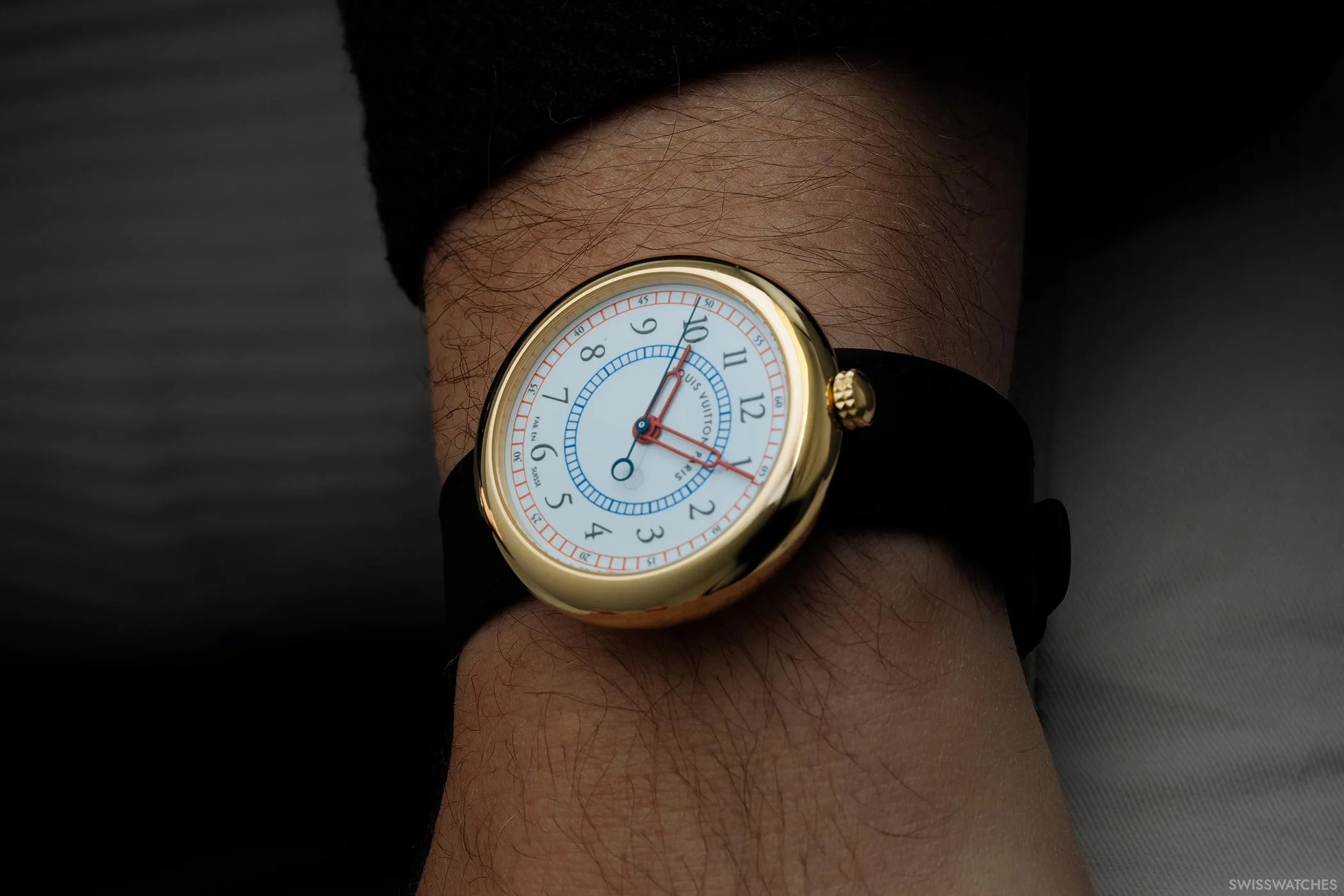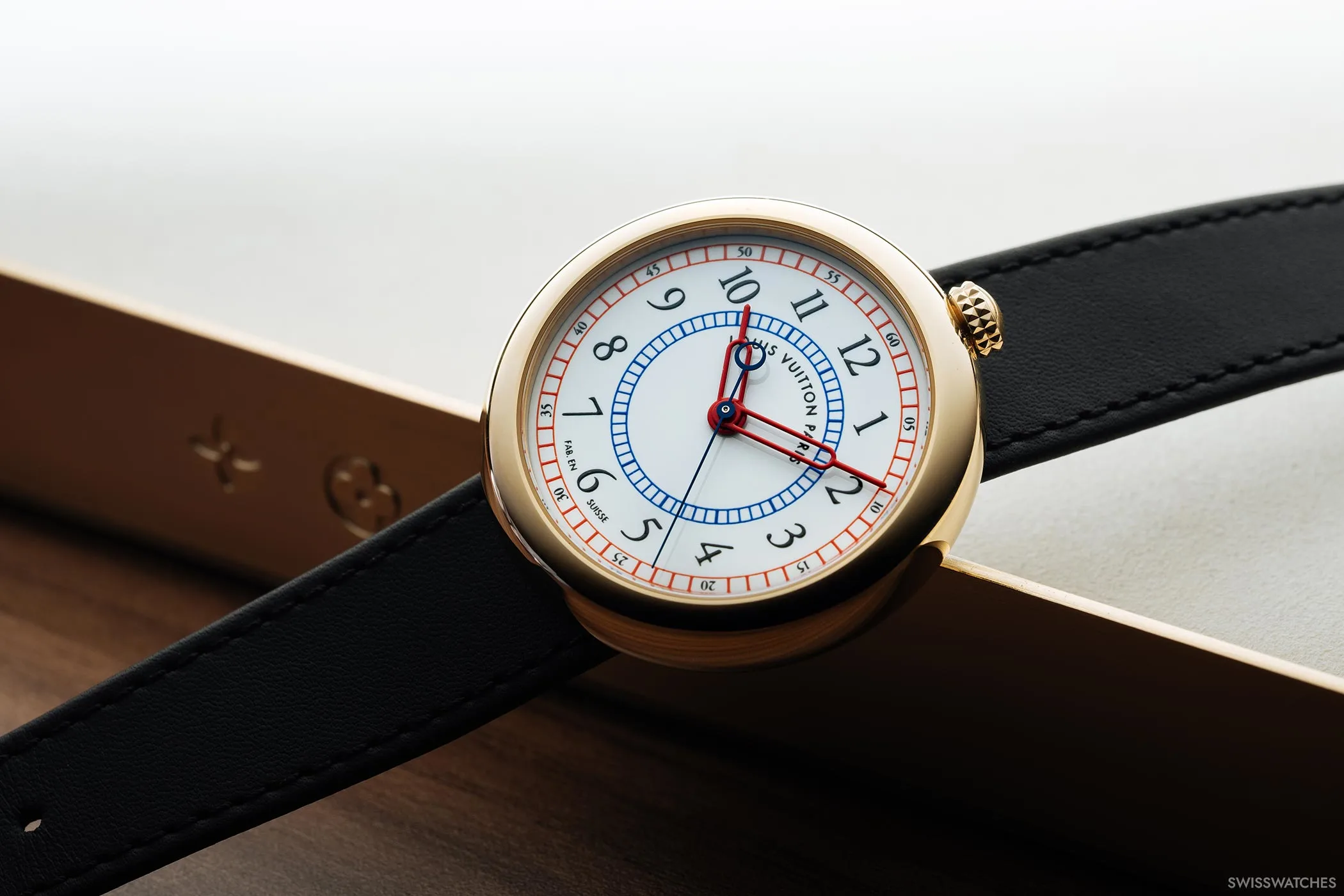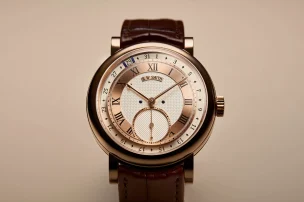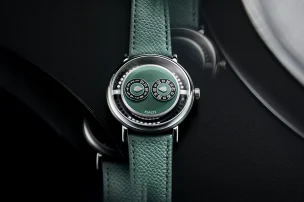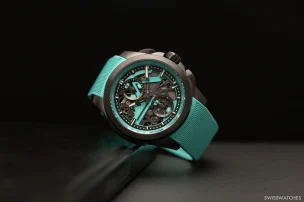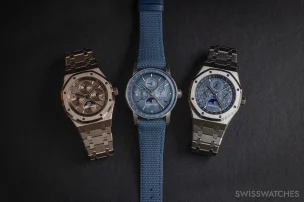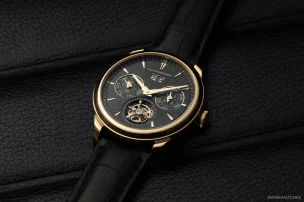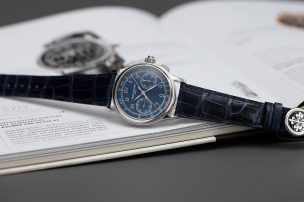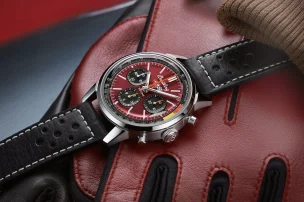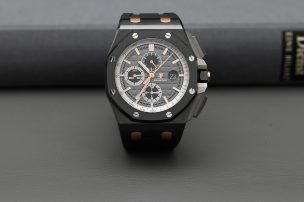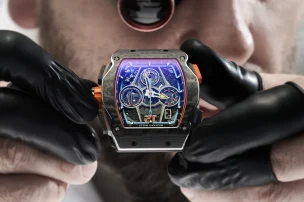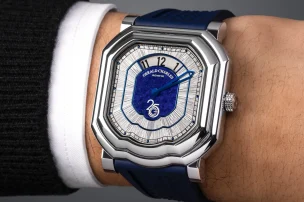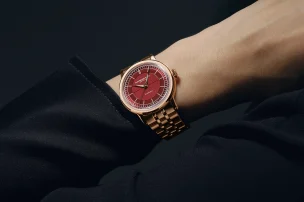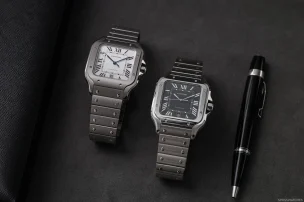

Louis Vuitton Monterey – A Masterclass in Revival
The new Louis Vuitton Monterey features a 39 mm yellow-gold case, Grand Feu enamel dial, automatic LFT calibre, and is limited to 188 pieces.
The Louis Vuitton Monterey has long enjoyed cult status for its unique fusion of design, architecture and innovative materials. Now, the model from 1988 is making a comeback in the form of a time-only limited edition of a mere 188 pieces, appearing with a carefully crafted Grand Feu enamel dial.
Louis Vuitton’s horological history is something of a black sheep within the mechanical Swiss watchmaking family. While many revered watch brands can point back to centuries of tradition, Louis Vuitton, founded in 1854 in Paris, only released its first mechanical watch in 2002 with the Tambour. Prior to its release, the only timekeeping items to emerge from the brand were travel clocks in the 1920s and 30s. With one exception: the Monterey.
The Monterey watches were conceived by visionary architect Gae Aulenti in 1988 – best known for her transformation of Paris’ Gare d’Orsay into the breathtaking Musée d’Orsay. Quirky, bold, and highly legible, these pebble-shaped quartz watches with Louis Vuitton leather straps were unexpected and avant-garde in terms of style. In many ways, Aulenti’s proclivity for structure, proportion and material in architecture was transfused into the watches.
The 1988 LV1, manufactured by IWC Schaffhausen, was a 40 mm watch in either white- or yellow-gold. It included numerous functions set around a single axis, including a distinctive railway track minute ring, a retrograde date, moonphase, GMT and 24 Time zones.


The Monterey II Alarm Travel Watch (LVII), likewise created by IWC on behalf of the fashion house, exuded style while also embracing LV’s strong relation to travel. One of the first ever ceramic watches, the 37 mm edition offered a second time zone and elegant pointer date. The fact that these watches were also a cross-collaboration was incredibly forward-thinking for the time.
From Montre to Monterey
Over the years, collectors began referring to the LV I and LV II by the affectionate nickname ‘Monterey’; derived from the American pronunciation of montre, the French word for watch. The name stuck. As vintage appreciation expanded, the Monterey became a fixture among tastemakers who valued its unconventional design language and limited production numbers.
Today, original examples rarely appear on the market, and when they do, they are coveted not only as symbols of 1980s design daring but also as early expressions of Louis Vuitton’s enduring creative audacity. Their reappearance on the wrists of models at the Women’s Fall-Winter 2025 show in Paris, chosen by Nicolas Ghesquière to complement his ready-to-wear looks, confirmed what insiders already knew: the Monterey was not only a watch, but an artefact of design culture.
Now, watch collectors as well as fans of the brand, which now of course produces its own mechanical Swiss-made watches at La Fabrique du Temps under revered watchmakers Michel Navas and Enrico Barbasini, will be pleased to learn that the unmistakable 80s-style Monterey is making a comeback. The new model, limited to a mere 188 pieces, draws upon the unmistakable ‘pebble’ form of the original Monterey wristwatches – and of course now sports a mechanical movement.
A Return to Form: The Case of the New Louis Vuitton Monterey
So how does the newly revived Monterey resemble, or indeed differ, from its historical counterparts? Firstly, the watch adopts a new case size of 39 mm – a nice compromise – presented in 18-carat yellow gold. It retains the distinctive pebble shape, rendered with mirror-polished curvature with Aulenti’s unusual case construction, as well as a crown at twelve o’clock in a nod to pocket watches.
Crafted and finished by hand at La Fabrique des Boîtiers Louis Vuitton, it recalls the tactile purity of the 1988 original. The widened, Clous de Paris-patterned crown offers both ergonomics and texture, while beneath the quick-release black calf leather strap, a hidden engraving reading ‘1 of 188’ quietly underlines its exclusivity. Finally, despite the Monterey’s impressive transformation into what could arguably be labelled a dress watch, the case offers a relatively sporty water-resistance to 50 m. The new Louis Vuitton Monterey is priced at €56,000.
“This watch represents a symbiosis between the old and the present. We retained the polished ‘pebble’ spirit, the unique leather attachment, and the iconic crown at twelve o’clock — all hallmarks of the 1988 LV I and LV II.”
– Matthieu Hegi, Artistic Director at La Fabrique du Temps Louis Vuitton.
Grand Feu dial
In a world increasingly driven by industrial production, Louis Vuitton’s choice of a Grand Feu enamel dial marks a deliberate return to pure craftsmanship – and one that undeniably renders the new Monterey more luxurious than its dynamic 1980s predecessors. Celebrating one of watchmaking’s most remarkable and challenging crafts, Grand Feu enamelling was an obvious choice thanks to its enduring lustre. The technique not only produces a beautifully glossy finish but also a subtle depth and tone that complements the graphic simplicity of the dial.
The process itself is painstaking. Over twenty hours of careful, manual work go into crafting a single dial. Multiple layers of vitreous enamel are hand-applied to a white-gold base, each interspersed with firings at temperatures between 800°C and 900°C – every stage carrying the risk of breakage. White enamel, notoriously difficult to perfect, demands particular expertise. The enamel powder is first inspected under a microscope for impurities, then hand-applied with a fine brush onto a pre-treated white-gold plate. Achieving the perfect tone requires five separate firings: a delicate base layer, followed by four more to build depth and opacity.
Once complete, the dial is lapped with paperglass to achieve an impeccably smooth surface before being slowly fired at 720°C – a process repeated ten times to achieve that soft, opaline glow characteristic of true hand-applied enamel. Only then does the stamping process begin: the ground enamel powder, in shades of blue, red, or black, is mixed into a smooth, paste-like texture ideal for precise enamel stamping. Over the course of two meticulous hours, the dial’s distinctive graphics are built up, with careful machine adjustments for each colour to achieve the desired hue, depth, and volume. A total of eight applications are required for every shade – four fired at 460°C, followed by another four at 600°C.
The colours are echoed in the matching white-gold hands – syringe-shaped and edged with red lacquer – and a blued-steel seconds hand that together nod to the original models. The twin signatures FAB. EN SUISSE and more prominently, LOUIS VUITTON PARIS, round out the dial, reaffirming the watch’s dual identity: Swiss watchmaking precision, Parisian style.
Yet the most significant departure from its quartz predecessors lies in its restraint. While the original models of 1988 incorporated multiple functions and, in turn, densely packed (although still pretty legible) dials, the new Monterey is pared back to a time-only display. This allows the enamel dial – and the purity of the design itself – to take centre stage, resulting in a more refined, quieter aesthetic that feels more attuned to contemporary taste.
Inside the Monterey: The Automatic LFT MA01.02 Calibre
Over to the movement: finally, the Monterey is bestowed with a movement it deserves, which comes in the form of the automatic calibre LFT MA01.02, developed and assembled entirely within La Fabrique du Temps Louis Vuitton. Though concealed behind a closed caseback, its finishing meets the high standards of haute horlogerie: a circular-grained mainplate, sandblasted bridges, and micro-satin edges. The 18-carat rose-gold rotor is trimmed with V-notches echoing the LV Monogram.
Running at 28,800 vibrations per hour and offering a 45-hour power reserve, the calibre embodies Louis Vuitton’s restrained approach to watchmaking. Beneath the barrel sits the discreet poinçon LFT – a quiet mark of distinction for those in the know. In many ways, this mechanical calibre completes the Monterey’s metamorphosis: from a design relic of the 1980s to a legitimate expression of twenty-first century haute horlogerie.
Positioning Louis Vuitton watchmaking
As recounted in our in-depth recounting of Louis Vuitton’s horological ascent from fashion house to esteemed Swiss watch producer, Louis Vuitton’s watchmaking evolution has been swift but sure-footed. Since establishing La Fabrique du Temps in 2011, Louis Vuitton has earned recognition not through imitation but through invention by working with métiers of its own, such as the stunning Grand Feu dial, blending forward-looking French design with Swiss watchmaking tradition. The revival of the Monterey, now made in-house and proudly featuring a mechanical movement, makes for the perfect embodiment of that synthesis.
The decision to revive the cult classic Monterey was surely a no-brainer: and it is also a signal from the manufacture to its followers that LV’s heritage truly does have the ability to be admired by collectors, despite its comparatively short history. It is simultaneously satisfying to see how far this brand has come: from an – albeit iconic – externally produced quartz watch model to a refined enamel timepiece that combines traditional crafts with a top-notch Swiss-made movement from Louis Vuitton’s own esteemed manufacture. With the Monterey’s revival, Louis Vuitton demonstrates that even a young maison in watchmaking years can possess heritage — provided it has the courage to reinterpret it.






